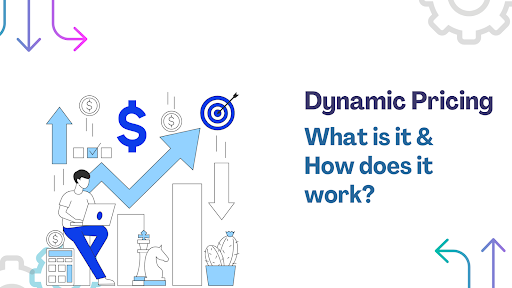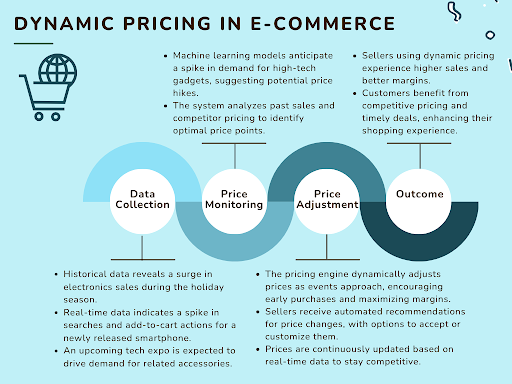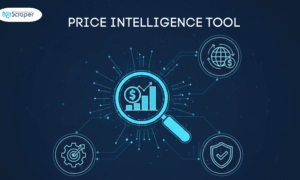Imagine a situation – It’s a rainy Friday night. Eager fans are waiting for cabs to go home after a concert. All the rideshare apps have kept their prices constant. The drivers now have very little incentive to venture out during these high-demand periods. The result? Longer wait times, frustrated riders, and a chaotic kerbside scene. This is one of the many situations highlighting the importance of dynamic pricing in the modern world.
What exactly is Dynamic Pricing?
It is a revenue-optimization strategy that involves continuously adjusting the price of a product or service based on various real-time factors like:
- Competitor pricing
- Demand fluctuations
- Consumer behavior
- Market conditions
Over the years, dynamic pricing has been an integral part of industries like e-commerce, quick commerce, ridesharing, hospitality, airlines, etc., due to its potential to maximize the bottom line without compromising customer experience.
How does Dynamic Pricing work?
Dynamic pricing relies on advanced price optimization algorithms and real-time data to arrive at optimal prices at any given time. Thanks to the complexity of modern markets, businesses have to adopt specialized pricing modules for various product categories and timelines to implement dynamic pricing successfully. Here are five types of dynamic pricing modules that are widely employed:
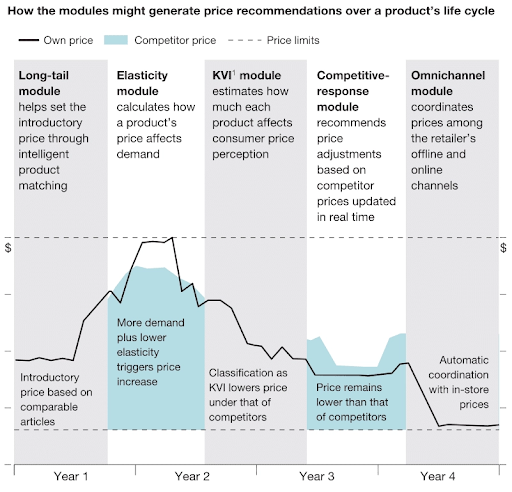
Source: McKinsey
- Long Tail Module – This module is used for new or niche products with limited sales history. In this, product attributes are used to estimate prices by linking them to similar, data-rich items.
- Elasticity Module – This module calculates the impact of price changes on demand, considering factors like seasonality and market cannibalization.
- Key Value Items (KVI) Module – Focuses on high-visibility items that significantly shape customer price perception. This helps businesses maintain a competitive image while managing margins.
- Competitive-Response Module – Allows real-time price adjustments based on competitor pricing, ensuring companies stay competitive without eroding margins.
- Omnichannel Module – Synchronizes prices across digital and physical channels, optimizing customer experiences and managing price discrimination.
Here’s a simple example where an e-commerce business uses the competitive-response module to adjust prices.
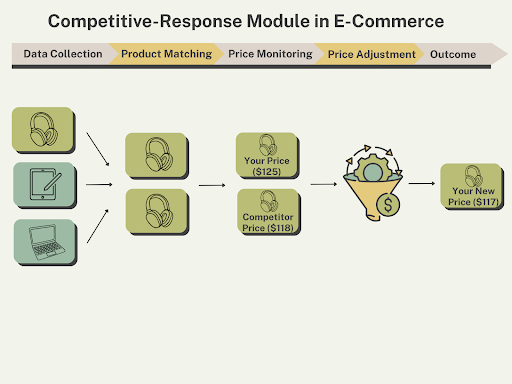
In the above example, the following steps are executed to arrive at an adjusted price:
-
- Data Collection: The process begins by collecting competitor pricing for different products from their database. Through data scraping, pricing data and supplementary data like product features, customer reviews, inventory levels, and promotional discounts are retrieved. Together, they help understand the full pricing context. In the above example, data about three products – headphones, tablets, and laptops is collected.
- Product Matching: The system matches your products with competitors’ offerings based on attributes like brand, model, and specifications. This step is crucial, as inaccurate matching can lead to faulty pricing decisions. In the above example, only the headphone moves to the next stage, while the tablet and laptop are excluded, as they are not sold by your business.
- Price Monitoring: The system continuously monitors competitor prices for the same product. Here, the competitor’s price at a given time is $118, while you are selling at $125.
- Price Adjustment: The pricing algorithm processes this data to determine an optimal response. This step involves complex calculations, including those related to price elasticity, margin requirements, and customer demand forecasting.
- New Price: Finally, the pricing algorithm suggests a new price based on the competitor insights. In this case, your headphone price is adjusted from $125 to $117, ensuring it is lower than your competitor’s.
Dynamic Pricing Across Industries
Here’s the working of dynamic pricing across different industries that also captures the different variables that the algorithm uses:
Hospitality
To suggest the optimal room pricing, a home-stay booking platform’s dynamic pricing algorithm considers variables such as:
- Seasonality
- Supply and demand
- Day of the week
- Special events and festivals
- Number of days left to book
- Historical performance of users’ listings
- Competitor occupancy and prices
- Number and quality of property reviews
Here are the different steps executed in arriving at an adjusted price in the hospitality industry:
Ridesharing
To set optimal fares, ridesharing platforms use dynamic pricing algorithms that consider variables such as:
- Time and distance
- Predicted route
- Estimated traffic
- Peak hours
- Current rider-to-driver demand
- Seasonal holidays and events
- Weather conditions
- Historical data and global news
Here are the different steps typically involved in arriving at an adjusted price in the ridesharing industry:
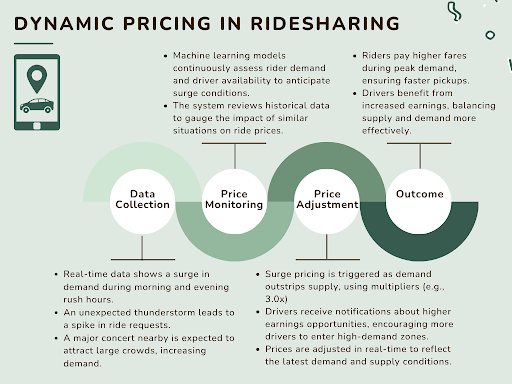
E-Commerce
To optimize revenue, e-commerce companies use dynamic pricing algorithms that factor in:
- Seasonality and major shopping events (e.g., Prime Day, Black Friday)
- Current supply and demand for specific products
- Day of the week and shopping trends
- Competitor pricing and stock levels
- Product reviews and ratings
- Historical sales performance and customer behavior
- Inventory levels and storage costs
Here are the different steps typically involved in arriving at an adjusted price in the e-commerce industry:
Best Practices in Dynamic Pricing
Implementing dynamic pricing can be daunting at first, but with the right strategies and best practices in place, you can harness its potential in no time. Here are five such best practices to follow while adopting dynamic pricing in your organization:
✅ Pay Attention to Overall Costs
Shoppers often make purchase decisions based on the complete “out-the-door” cost. This includes taxes, shipping, service fees, and any additional charges. Focusing solely on item price without accounting for these factors can undermine the effectiveness of your dynamic pricing strategy.
For example, a furniture retailer discovered that customers were willing to wait longer for deliveries if it meant lower overall costs. By algorithmically offering weekend delivery options with reduced fees, they improved customer satisfaction without significantly impacting conversion rates.
✅ Avoiding Over-Reliance on Algorithms
While algorithms are powerful tools for implementing dynamic pricing at scale, relying too heavily on them can backfire. Automated pricing systems can make significant errors or provoke customer backlash if they fail to account for human judgment.
For instance, an e-commerce business once listed a non-bestselling book for an astronomical $23.7 million due to an unchecked feedback loop between two automated pricing bots. One seller’s algorithm was set to price slightly higher than the other, leading both prices to spiral out of control without human oversight.
✅ Avoid Setting Insensitive Pricing Rules
Dynamic pricing must be applied with a sense of ethics and awareness of market sentiment. An infamous example is the backlash Sony Music faced when the price of Whitney Houston’s album on Apple’s iTunes Store spiked from $4.99 to $7.99 just hours after her passing.
While the algorithm’s response to increased demand was technically accurate, the timing created a perception of profiteering and damaged the brand’s reputation. This highlights the importance of context in pricing decisions, where short-term gains can come at the cost of long-term customer trust.
✅ Don’t Ignore Seasonal Demand Fluctuations
Dynamic pricing is particularly challenging when dealing with seasonal demand spikes. This is the time when customers are less price-sensitive and more focused on urgency. During these periods, you have a limited window to maximize profits, making precise demand forecasting and pricing adjustments crucial.
Amazon capitalized on the seasonal demand for Pumpkin Pie Spice, increasing its price from $4.49 to as high as $8.49 during Thanksgiving and Christmas, when demand peaked. This strategy leveraged the fact that customers buying such niche, time-sensitive products tend to have lower price elasticity, making them more accepting of higher prices.
✅ Keep Customers at the Center of Your Strategy
For your dynamic pricing strategy to be truly effective, you must prioritize customer perceptions and buying psychology, not just profit margins.
A high-end accessories retailer tested dynamic pricing for 500,000 SKUs. They discovered that customers were willing to upgrade from a $350 item to a $399 item, but not to a $400 one, revealing critical psychological pricing thresholds. This insight helped them improve margins and automate price setting while avoiding customer alienation.
Wrap Up
Whether you’re an e-commerce business, a ridesharing company, or even a hospitality business, adopting dynamic pricing can be the catalyst to maximizing revenue and outpacing your competitors. By continuously monitoring competitor prices using the right tools and integrating this intelligence into your pricing strategy, you can capitalize on various opportunities to capture a larger share of the market.

